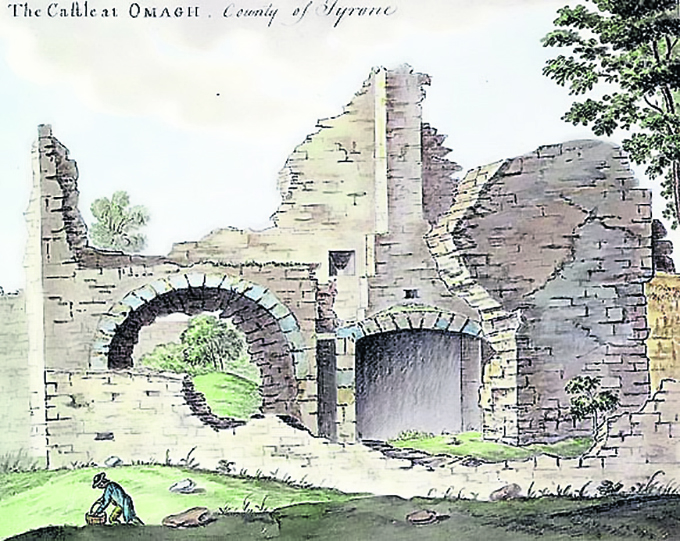TWO Tyrone castles, brought to life through the watercolours of 18th-century artist Gabriel Beranger, are now being made publicly accessible for the first time, writes Éamon Ó Caoineachán.
The rare paintings – depicting strongholds once held by the O’Neills – form part of ‘A Collection of Drawings of the Principal, Antique Buildings of Ireland,’ which is housed in the National Library of Ireland. The artworks, sourced from a private collection, offer a rare glimpse into Gaelic architecture and landscape, preserved through Beranger’s eye and brush. The collection includes two castle scenes from Tyrone, painted during Beranger’s travels in the 1770s.
These watercolours are described by the library as “topographical drawings of Irish antiquities” and serve as invaluable visual records of buildings now vanished or ruined.
Harry Avery’s Castle
The first of these paintings is titled ‘A castle said to have belong’d to the O’Neills near Newtown-Stewart, County of Tyrone.’ It is now widely identified as Harry Avery’s Castle, a formidable Gaelic structure built around 1320. Set against a lush Tyrone landscape, Beranger’s image captures the ruined but commanding presence of the castle that once served as a seat of power for the O’Neill clan.
The castle’s namesake, Harry Avery, was the anglicised name for Éinrí Aimhréidh Ó Néill, a 14th-century chieftain remembered in the Annals of the Four Masters as a just and noble leader. The castle remains today as one of the few examples of native Irish stone fortifications not built by Norman or English hands.
Though in ruins, the twin towers of Harry Avery’s Castle still dominate the hillside, their “stoneless stoic eyes” inviting the viewer to imagine the lives once lived within.
Omagh Castle
The second Tyrone castle captured by Beranger is titled ‘The Castle at Omagh, County of Tyrone.’ Unlike Harry Avery’s Castle, no physical trace of this structure remains today. Yet Beranger’s painting offers a unique and historically significant visual record of what once stood at the confluence of the Camowen, Drumragh, and Strule rivers – an area now at the centre of Omagh town.
The castle is believed to have been located near Market Street, close to the Dublin Road, and may be faintly indicated on early 17th-century plantation maps. However, the National Library of Ireland notes, “No trace of the castle remains today and there is no record of a castle at Omagh.” This makes Beranger’s image all the more vital to historians and heritage enthusiasts.
In the foreground of the Omagh castle scene, a figure – perhaps a local resident – is shown with a basket. It’s a quiet, human moment that draws the viewer into a lost world, inviting questions about the daily life and routine that once surrounded the imposing structure.
A Window into Gaelic Heritage Beranger’s paintings evoke a sense of place, memory, and identity – particularly in regions like Tyrone where Gaelic culture once flourished and later came under siege.
In a time when few visual records of Ireland’s native-built castles remain, Beranger’s brushstrokes bring stone and story back to life.
– Éamon Ó Caoineachán (Eddie Keenaghan) is a poet, writer and historian from Bundoran, Co Donegal.







